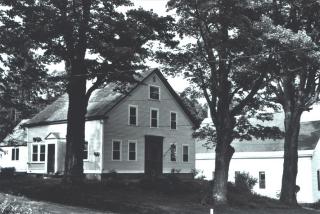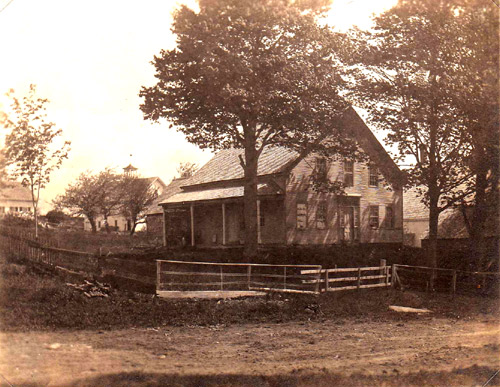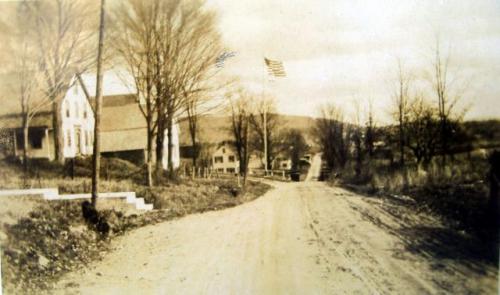The Nathan Gould House

The History of the Gould House:
The Gould House was built in the “new” town center of Stoddard in 1833. Nathan Gould originally built a farmhouse in 1815 on the Old Keene Road, about 1/2 mile south of the Butterfield House and some distance from the current village. He bought a building lot in the new village setting in the early 1830s and built his new home there in 1833. Historical records indicate that Gould “rebuilt/moved’ his farmhouse to make his village home. He dismantled the farmhouse and used the wood and timbers to build his new house in the village.
The town center moved to this new location for commercial and institutional reasons. As with numerous other villages throughout New Hampshire, this move was influenced by the construction of a new road. The new Forest Road was laid out in 1832, offering an easier climb up the slopes of Pitcher Mountain, and bypassing the old village center along and around present-day School Street (formerly Queen Street). With the new road enjoying more traffic, the village’s retail businesses, professional offices and post office quickly moved down the hill to take advantage of this new busier location. The churches, school and town hall soon followed. The result was a rapid change for the town. Most of the homes in the new center were constructed prior to 1845. Although six of those homes, retail structures and the one-room school house were lost over the next century and a half, most of the structures surviving in the village today date from that period.
Nathan Gould was one of the first residents to make the move into the new village and take advantage of the busy setting. By the 1830s he was an established carpenter and cabinetmaker, well into a career that would see him work on more than one hundred homes in the area. This location made Gould more visible and more accessible to his customers. He had farmed on a moderate scale at his home on the Keene Road, but he now focused more on his profession as carpenter/cabinetmaker. The new village was the logical place to do that.
Gould was not alone in his move away from the farm. By the 1830s the population of Stoddard was already declining as farm families moved away to find better land or a more stable form of income. Nathan Gould did that by moving to the new village and relying on his skill as a carpenter and on his income from his ox yoke mill. Many of his neighbors followed suit as Stoddard Center became the retail and institutional center for the town.
Who was Nathan Gould? Click on the link below to find out more about Gould, his Revolutionary War father, Simeon, and other members of his family.

Earliest Known Photo of the Gould House, from the late 1800s. Cutter place and barn in background.
Significance of the Gould House:
The Gould House, along with the Stoddard Town Hall, is listed on the New Hampshire Register of Historic Places. This is a great honor for the Town of Stoddard, as only the most suitable properties in New Hampshire are placed on this Register.
The Gould House is historically significant for several reasons. It is a fine example of Greek Revival architecture, it is the work of a well known local craftsman and it is an essential architectural element in a 19th century integrated historical neighborhood. Furthermore, the structure illustrates the transformation of a typical New Hampshire hill town from family farm to settled village to bedroom community.
The Gould House retains its Greek Revival architectural details. It also retains approximately one-half of its original interior woodwork, plaster walls, fireplaces, and other historical details. All of this was completed by Stoddard country carpenter and cabinetmaker Nathan Gould, who was the original resident of the house. Gould built or worked on more than one hundred local homes during his career, which spanned approximately forty years between 1810 and 1850. Gould was also a miller, carriage and sleigh maker, and a cabinetmaker who crafted furniture for the local market.
Prior to the 1980s this house was altered very little because the owners did not have the need, desire or means to do so. The two families who owned the house from the 1980s to 2008 did modernize and update the structure. Although the house has been altered for modern living over the last twenty-five years, the owners have been careful to preserve many of the architectural details from the 1830s.
The exterior of the house retains its Greek Revival details. The style and mass of the house is clearly as it was when constructed 175 years ago. The Greek Revival trim and detail remain on the building. This includes the elaborate main entry door surrounds, decorative enframement and side and transom lights. The center chimney also remains intact. The one change that affected the original appearance of the exterior was the installation of new windows within the last twelve years. The layout and design of the windows appear historically appropriate, but they are clearly modern replacements. A sliding glass door was also installed in the back wall of the ell, but it is not visible from the street.
Most of the architectural details also remain in the interior of the front half of the main structure, with the exception of the front curving staircase and the windows. Despite the modernization in the kitchen and ell area of the house, the original woodwork and other interior details in the front half of the house and the borning room, located in the northwest corner of the main structure, remain as evidence of the craftsmanship of builder Nathan Gould.
The 2½ story country Greek Revival style is clearly in evidence and is appropriate for the village setting, blends well with the surrounding period structures, and is an integral component in the essentially unaltered 19th century village of Stoddard Center. The village consists of almost twenty mid-19th century structures. All of these buildings add to the historical character of the village. This is especially true of the Gould House because of its Greek Revival details and its location at the center of the village adjacent to the Stoddard Town Hall. The preservation of all of these structures is important to the history and character of the village.
The Gould House also illustrates the typical development of a New Hampshire hill town. It is aperfect example of the trend from farming to village living, and then to the role of the bedroom community in saving dying New Hampshire hill towns. Nathan Gould literally reconstructed his 1815 farmhouse into a new residential dwelling in the developing village center in 1833. Other farmers soon left the agricultural life behind, but most of them abandoned their farms and left the town entirely. As the hill farms died and poor transportation systems and an emerging global economy destroyed Stoddard’s limited industry, the population of the town decreased by more than 90% in the century between the 1820s and the 1920s. Many of the surviving historic homes in Stoddard were saved decades later by an improved form of transportation – the automobile. For more than 40 years the Gould House has been the home of families who were able to live here because they could commute to nearby towns and cities (Keene, Peterborough, Hillsborough) which offered employment. Stoddard became a bedroom community and the population of the town has increased by 300% during those years.

Intersection of King & Queen St looking east. The first house on the left is the Nathan Gould House, with a small barn between the Goud House and the Town Hall.

